Bavaria - Weidenhofen chapel
| bottom |
Homepage Feedback? Enter your comments in the guest book |
Paris | |
| Previous | Back to Travelogue | Next |
3 of 15 |
|
Click on any picture to bring up the picture enlarged in a new window |
|||
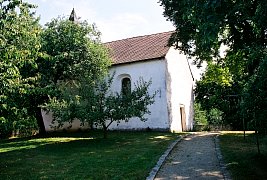 This farm was once part of the monastery at Oberaltaich. The government seized
the monastery's land in 1802 and sold it off. Our distant relative married
the widow who lived here, and our German relatives have lived here ever since.
This farm has a very distinct building on it.
In 1485 the Catholic church of St. Mary was built here. It was built next to
a gentle stream. At one points half of the church collapsed into this
stream. It's hard to imagine that this little brook
at some point over a 500 year span could become a destructive flood.
The half that remained standing was
turned into this chapel. Over the years
generations Frieda's family have served as caretakers. Frieda's parents put a lot of work into restoring
the chapel. A wall has been built to protect the chapel from
future floods.
This farm was once part of the monastery at Oberaltaich. The government seized
the monastery's land in 1802 and sold it off. Our distant relative married
the widow who lived here, and our German relatives have lived here ever since.
This farm has a very distinct building on it.
In 1485 the Catholic church of St. Mary was built here. It was built next to
a gentle stream. At one points half of the church collapsed into this
stream. It's hard to imagine that this little brook
at some point over a 500 year span could become a destructive flood.
The half that remained standing was
turned into this chapel. Over the years
generations Frieda's family have served as caretakers. Frieda's parents put a lot of work into restoring
the chapel. A wall has been built to protect the chapel from
future floods.
|
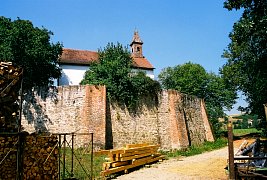
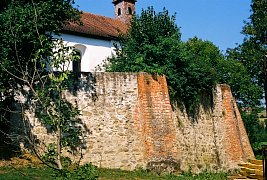
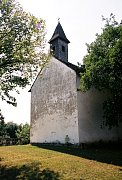
|
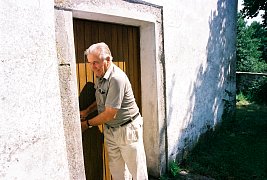 Frieda's father, my mom's first cousin, unlocks the chapel so
we can go in.
Frieda's father, my mom's first cousin, unlocks the chapel so
we can go in.
|
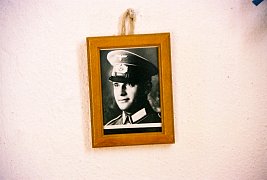
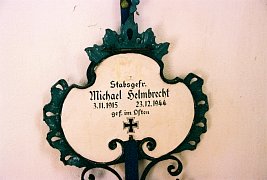 Frieda's father's two brothers
fought in World War II and were killed.
Memorial's to them were lovingly constructed by their surviving
brother. One of Frieda's mother's brothers
was also killed. They showed me a picture
of him sitting on a shiney tank that must
have just come from the factory.
Frieda's father's two brothers
fought in World War II and were killed.
Memorial's to them were lovingly constructed by their surviving
brother. One of Frieda's mother's brothers
was also killed. They showed me a picture
of him sitting on a shiney tank that must
have just come from the factory.
|
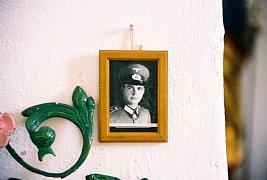
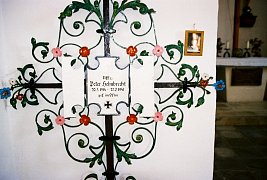
|
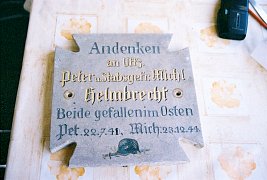 Another relic created by a man in memory of his brothers. I asked with all
three brothers in the army, who did the farm work during the war? First they
had a Polish man and then a Frenchman and a Russian woman. The Frenchman was
even observed sneaking into the Russian woman's room once.
I am sure they were
conscripted labor. Fifty years after being forced to work here the Frenchman
returned with his family. He knew two brothers were dead, but he didn't
know if Frieda's father lived through the war. He knew the family well enough that he could find
the family burial
plot at
Oberaltaich
church. Not
seeing Frieda's
father name on any
monuments, he came
out to the farm.
He brought with him a picture
given to him by the family of all three brothers together at the farm. The Frenchman
said he had been well treated here.
Another relic created by a man in memory of his brothers. I asked with all
three brothers in the army, who did the farm work during the war? First they
had a Polish man and then a Frenchman and a Russian woman. The Frenchman was
even observed sneaking into the Russian woman's room once.
I am sure they were
conscripted labor. Fifty years after being forced to work here the Frenchman
returned with his family. He knew two brothers were dead, but he didn't
know if Frieda's father lived through the war. He knew the family well enough that he could find
the family burial
plot at
Oberaltaich
church. Not
seeing Frieda's
father name on any
monuments, he came
out to the farm.
He brought with him a picture
given to him by the family of all three brothers together at the farm. The Frenchman
said he had been well treated here.
|
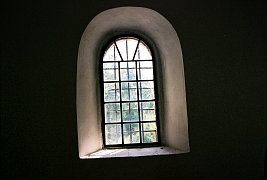 I took this picture to show how thick the walls of the chapel are.
I took this picture to show how thick the walls of the chapel are.
|
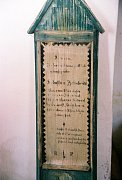 Here is the wooden grave marker for my great grandfather - the first
ancestor Frieda and her siblings and I share in common.
The custom was to lie the body out on this wooden marker and then
carry the body to the cemetery on it. Afterwards, the board served
as the grave marker. At some point this marker was brought
inside the chapel for safe-keeping.
Here is the wooden grave marker for my great grandfather - the first
ancestor Frieda and her siblings and I share in common.
The custom was to lie the body out on this wooden marker and then
carry the body to the cemetery on it. Afterwards, the board served
as the grave marker. At some point this marker was brought
inside the chapel for safe-keeping.
It says (translated), "For a religious remembering in honor respected Sebastian Helmbrecht, farmer of Weidenhofen, who died on 2/26/1901 after a long and heavy illness and after getting the last sacraments at the age of 61 years, blessed in God." There follows a poem, then R.I.P. (latin "Requiescat In Pace"). |
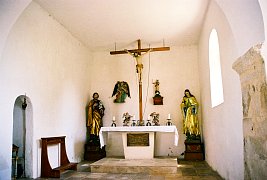 The front of the chapel showing the altar. This is still an
official Catholic chapel - services are held here infrequently, and
sometimes marriages are held here. Frieda's mom and dad have done
a lot of work over the years to restore both the inside and outside
of this chapel. At one time a yearly processing took place from
this chapel to the larger monastery church of Oberaltaich.
The statues are from the late 19th century (Hazarener style), the left hand one is holy Joseph,
on right hand side is holy Margaret. On the wall left is an
angel in accountment, right on the wall is the holy Mary.
The front of the chapel showing the altar. This is still an
official Catholic chapel - services are held here infrequently, and
sometimes marriages are held here. Frieda's mom and dad have done
a lot of work over the years to restore both the inside and outside
of this chapel. At one time a yearly processing took place from
this chapel to the larger monastery church of Oberaltaich.
The statues are from the late 19th century (Hazarener style), the left hand one is holy Joseph,
on right hand side is holy Margaret. On the wall left is an
angel in accountment, right on the wall is the holy Mary.
|
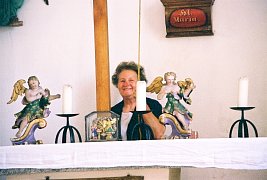 Frieda's mom rings the church bell. I asked her dad what the year
was cast on the bell and he said "1890".
Frieda's mom rings the church bell. I asked her dad what the year
was cast on the bell and he said "1890".
Listen to the Bell You can hear my camera click as I take this picture. |
| top |
Homepage Feedback? Enter your comments in the guest book |
Paris | |
| Previous | Back to Travelogue | Next |
3 of 15 |
|
Click on any picture to bring up the picture enlarged in a new window |
|||